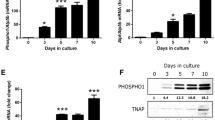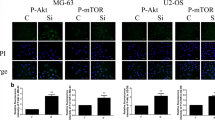Abstract
Osteoblasts and osteoclasts maintain bone volume. Acidosis affects the function of these cells including mineral metabolism. We examined the effect of acidosis on the expression of transcription factors and mineralization in human osteoblasts in vitro. Human osteoblasts (SaM-1 cells) derived from the ulnar periosteum were cultured with α-MEM containing 50 μg/ml ascorbic acid and 5 mM β-glycerophosphate (calcifying medium). Acidosis was induced by incubating the SaM-1 cells in 10 % CO2 (pH approximately 7.0). Mineralization, which was augmented by the calcifying medium, was completely inhibited by acidosis. Acidosis depressed c-Jun mRNA and increased osteoprotegerin (OPG) production in a time-dependent manner. Depressing c-Jun mRNA expression using siRNA increased OPG production and inhibited mineralization. In addition, depressing OPG mRNA expression with siRNA enhanced mineralization in a dose-dependent manner. Acidosis or the OPG protein strongly inhibited mineralization in osteoblasts from neonatal mice. The present study was the first to demonstrate that acidosis inhibited mineralization, depressed c-Jun mRNA expression, and induced OPG production in human osteoblasts. These results suggest that OPG is involved in mineralization via c-Jun in human osteoblasts.







Similar content being viewed by others
References
Arnett TR (2010) Acidosis, hypoxia and bone. Arch Biochem Biophys 503:103–109
Krieger NS, Frick KK, Bushinsky DA (2004) Mechanism of acid-induced bone resorption. Curr Opin Nephrol Hypertens 13:423–436
Brandao-Burch A, Utting JC, Orriss IR, Arnett TR (2005) Acidosis inhibits bone formation by osteoblasts in vitro by preventing mineralization. Calcif Tissue Int 77:167–174
Frick KK, Bushinsky DA (1999) In vitro metabolic and respiratory acidosis selectively inhibit osteoblastic matrix gene expression. Am J Physiol 277:F750–F755
Disthabanchong S, Radinahamed P, Stitchantrakul W, Hongeng S, Rajatanavin R (2007) Chronic metabolic acidosis alters osteoblast differentiation from human mesenchymal stem cells. Kidney Int 71:201–209
Yamaji Y, Moe OW, Miller T, Alpern RJ (1994) Acid activation of immediate early genes in renal epithelial cells. J Clin Invest 94:1297–1303
Frick KK, Jiang LI, Bushinsky DA (1997) Acute metabolic acidosis inhibits the induction of osteoblastic egr-1 and type 1 collagen. Am J Physiol 272:C1450–C1456
Arnett TR, Boyde A, Jones SJ, Taylor ML (1994) Effects of medium acidification by alteration of carbon dioxide or bicarbonate concentrations on the resorptive activity of rat osteoclasts. J Bone Miner Res 9:375–379
Arnett TR (2008) Extracellular pH regulates bone cell function. J Nutr 138:415S–418S
Shaulian E, Karin M (2002) AP-1 as a regulator of cell life and death. Nat Cell Biol 4:E131–E136
Takayanagi H, Kim S, Koga T, Nishina H, Isshiki M, Yoshida H, Saiura A, Isobe M, Yokochi T, Inoue J, Wagner EF, Mak TW, Kodama T, Taniguchi T (2002) Induction and activation of the transcription factor NFATc1 (NFAT2) integrate RANKL signaling in terminal differentiation of osteoclasts. Dev Cell 3:889–901
Stein GS, Lian JB, Van Wijnen AJ, Montecino M (1996) Transcriptional control of osteoblast growth and differentiation. Physiol Rev 76:593–629
Rubin J, Fan D, Wade A, Murphy TC, Gewant H, Nanes MS, Fan X, Moerenhout M, Hofstetter W (2000) Transcriptional regulation of the expression of macrophage colony stimulating factor. Mol Cell Endocrinol 160:193–202
Panizo S, Cardus A, Encinas M, Parisi E, Valcheva P, López-Ongil S, Coll B, Fernandez E, Valdivielso JM (2009) RANKL increases vascular smooth muscle cell calcification through a RANK-BMP4-dependent pathway. Circ Res 104:1041–1048
Ecarot-Charrier B, Glorieux FH, van der Rest M, Pereira G (1983) Osteoblasts isolated from mouse calvaria initiate matrix mineralization in culture. J Cell Biol 96:639–643
Grigoriadis AE, Wang ZQ, Cecchini MG, Hofstetter W, Felix R, Fleisch HA, Wagner EF (1994) c-Fos: a key regulator of osteoclast-macrophage lineage determination and bone remodeling. Science 266:443–448
Wang ZQ, Ovitt C, Grigoriadis AE, Möhle-Steinlein U, Rüther U, Wagner EF (1992) Bone and haematopoietic defects in mice lacking c-fos. Nature 360:741–745
Grigoriadis AE, Schellander K, Wang ZQ, Wagner EF (1993) Osteoblasts are target cells for transformation in c-Fos transgenic mice. J Cell Biol 122:685–701
Fleischmann A, Hafezi F, Elliott C, Remé CE, Rüther U, Wagner EF (2000) Fra-1 replaces c-Fos-dependent functions in mice. Genes Dev 14:2695–2700
Eferl R, Hoebertz A, Schilling AF, Rath M, Karreth F, Kenner L, Amling M, Wagner EF (2004) The Fos-related antigen Fra-1 is an activator of bone matrix formation. EMBO J 23:2789–2799
Frick KK, Bushinsky DA (1998) Chronic metabolic acidosis reversibly inhibits extracellular matrix gene expression in mouse osteoblasts. Am J Physiol 275:F840–F847
Frick KK, Bushinsky DA (2003) Metabolic acidosis stimulates RANKL RNA expression in bone through a cyclo-oxygenase-dependent mechanism. J Bone Miner Res 18:1317–1325
Simonet WS, Lacey DL, Dunstan CR, Kelley M, Chang MS, Lüthy R, Nguyen HQ, Wooden S, Bennett L, Boone T, Shimamoto G, DeRose M, Elliott R, Colombero A, Tan HL, Trail G, Sullivan J, Davy E, Bucay N, Renshaw-Gegg L, Hughes TM, Hill D, Pattison W, Campbell P, Sander S, Van G, Tarpley J, Derby P, Lee R, Boyle WJ (1997) Osteoprotegerin: a novel secreted protein involved in the regulation of bone density. Cell 89:309–319
Yasuda H, Shima N, Nakagawa N, Mochizuki SI, Yano K, Fujise N, Sato Y, Goto M, Yamaguchi K, Kuriyama M, Kanno T, Murakami A, Tsuda E, Morinaga T, Higashio K (1998) Identity of osteoclastogenesis inhibitory factor (OCIF) and osteoprotegerin (OPG): a mechanism by which OPG/OCIF inhibits osteoclastogenesis in vitro. Endocrinology 139:1329–1337
Barreto DV, Barreto Fde C, Carvalho AB, Cuppari L, Draibe SA, Dalboni MA, Moyses RM, Neves KR, Jorgetti V, Miname M, Santos RD, Canziani ME (2008) Association of changes in bone remodeling and coronary calcification in hemodialysis patients: a prospective study. Am J Kidney Dis 52:1139–1150
Mikami S, Hamano T, Fujii N, Nagasawa Y, Isaka Y, Moriyama T, Matsuhisa M, Ito T, Imai E, Hori M (2008) Serum osteoprotegerin as a screening tool for coronary artery calcification score in diabetic pre-dialysis patients. Hypertens Res 31:1163–1170
Komoto S, Kondo H, Fukuta O, Togari A (2012) Comparison of β-adrenergic and glucocorticoid signaling on clock gene and osteoblast-related gene expression in human osteoblast. Chronobiol Int 29:66–74
Acknowledgments
The authors thank Dr. Y. Koshihara for donating the SaM-1 cells. This study was partly supported by a Grant-in-Aid for Scientific Research (20592193 to A.T.) from the Japan Society for the Promotion of Science and by a Grant-in Aid from the Strategic Research AGU-Platform Formation (2008–2012).
Author information
Authors and Affiliations
Corresponding author
Additional information
The authors report that they have no conflict of interest.
Rights and permissions
About this article
Cite this article
Takeuchi, S., Hirukawa, K. & Togari, A. Acidosis Inhibits Mineralization in Human Osteoblasts. Calcif Tissue Int 93, 233–240 (2013). https://doi.org/10.1007/s00223-013-9746-2
Received:
Accepted:
Published:
Issue Date:
DOI: https://doi.org/10.1007/s00223-013-9746-2




